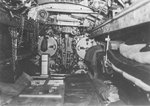Glider,
I'm in a hurry so I'll just address your comments the Type XXI.
The Type XXI featured much better habitability than any US boat. Fitted with an automatic schnorchel several airconditioning systems the boat was continously vented and kept odour free while temperature was kept at a constant comfortable level. Besides this the Type XXI boat featured large crew comfort areas as-well as multiple showers, large storage freezers, kitchens, bathrooms etc etc..
The Type XXI was unequalled in every way..
I'm in a hurry so I'll just address your comments the Type XXI.
The Type XXI featured much better habitability than any US boat. Fitted with an automatic schnorchel several airconditioning systems the boat was continously vented and kept odour free while temperature was kept at a constant comfortable level. Besides this the Type XXI boat featured large crew comfort areas as-well as multiple showers, large storage freezers, kitchens, bathrooms etc etc..
The Type XXI was unequalled in every way..

